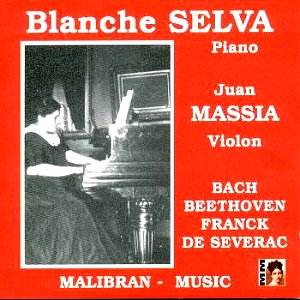Blanche Selva, one of the most revered of French pianists
of her generation, made pitifully few recordings and even those were
compressed into a two-year period. Her discography in fact amounts to
no more than a mere eleven works, three of them in collaboration with
the Catalan violinist Joan Massia (two of which Malibran present here).
Six of the eleven were of works by Déodat de Séverac –
who still retains a tentative toe in current discographic waters – two
were by Bach, two by Franck and one by Beethoven. This is a small return
for so important a figure but, accustomed to resurrecting leading figures
of French inter-war life, Malibran has come to her rescue (and incidentally
to Massia’s as well – there wasn’t room here for their Columbia set
of the Franck Violin Sonata so maybe Malibran will include that in a
forthcoming issue).
Trained at the Schola Cantorum, Selva was appointed
by d’Indy himself as teacher at the early age of eighteen. In all she
taught there for twenty years and was adventurous enough to add her
own twist to the usual continental drift westwards of Czech musicians
– Selva herself moving to Prague to teach (at around the time Martinů
and so many others were off to Paris) and encountering Suk and Novák
along the way. She was a front rank exponent of Albeniz, d’Indy himself
(Malibran’s notes say that Selva “detached herself” from the Schola
Cantorum in the early 1920s but I was under the impression that
she and d’Indy fell out), Roussel and many others. She gave the complete
Bach keyboard works as a cycle (beginning in Paris in 1904 and a number
of times after) as she subsequently gave the complete "32"
of Beethoven on several occasions. She settled in Catalonia in the mid-twenties
but suffered a stroke shortly after making some of the discs to be heard
here and from then her concert-giving days were over. She left Barcelona
– where she had taught – after the Civil War and died pretty much forgotten
in France in 1942.
Her Bach Partita is a precious souvenir of her playing.
The Prelude is limpidity itself and the clarity and pointing of the
stylish and apt Allemande truly impressive. Her chordal weighting in
the Courante and her rather cool undemonstrative musicality all point
to a major Bach player of the most august French school. The dynamics
of the concluding Fugue are splendidly controlled and her throwaway
ending insouciant in the extreme. If anything the Franck is even better
and stands alongside the almost contemporaneous Cortot recording as
twin poles of French School Franck interpretation. She plays the Prelude
with exceptional understanding of line and depth of weight, a tremendous
sense of clarity and a control that never precludes metrical freedom.
The rolled chords of the Choral disclose a movement that is short neither
on detail nor on affection; nothing however is unduly romanticised and
everything is subordinated to acid architectural considerations. Hers
is a deeply serious and affecting musicality – the finger slip at 4.35
unquestionably let through in the interests of heightened expressivity.
The purposeful warmth of the Fugue is not compromised by unnecessary
lingering; reminiscences of the second movement are all the more moving
for their sheer unvarnished candour. Wonderful playing.
She was long a proponent of the music of the Languedoc-Provencal
composer Déodat de Séverac and even wrote a biography
of him. She revels in his fresh air impressionism – how elliptically
she points the end of Baigneuses au soleil and how charmingly
she vests Vers le mas en fête with such drama and such
colour. To the mild exoticisms of Les muletiers devant le Christ
de Llivia can be added Selva’s own virtuosity and flair for colouristic
potential – and she somehow ties the work to its Franckian antecedents
with the simplest of inflexions. She joins with Massia for the Bach
movement from the third Violin Sonata. He has a rather thin tone, unwarmed
by much vibrato, and his shifts sound surprisingly awkward. His trill
is also inclined to be a bit rough and his whole musicality is profoundly
old fashioned in the context of the day. Selva is quite a way back in
the balance unfortunately. In the Spring Sonata one’s initial
impressions of Massia are reinforced. He is inclined to be heavy going
in the opening Allegro, slow and with unvaried and limited vibrato,
prominent portamenti. Selva is once again somewhat occluded in the balance
but we can still hear and admire her animated rhythm and her subtle
bass pointing. The slow movement is reasonable but some of the jokey
rhythms of the Scherzo are rather smoothed over and the finale is short
on humour and elation – its soft grained nature co-exists with fine
co-ordination between the two and Massia does essay some lightly textured
bowing that is interesting to hear. On this showing however Massia was
No. rival to the much more forward-looking tonalist and compatriot Manuel
Quiroga – whose glinting, glittering morceaux discs rather put the antiquated
Massia in the shade.
This is a prized disc. Selva’s small body of recordings
is conspicuously important and we have a sizeable chunk here. For all
my strictures Massia is an engaging and by no means unimportant figure
in Catalan music making; his Franck Sonata with Selva conforms to the
qualities and limitations expressed earlier but Malibran would do a
great service in publishing it. I’d also never seen a picture of the
obscure fiddler and courtesy of the booklet I’ve now seen two. To those
whose prerequisites in French pianism of the 1920s are Cortot, Cortot
and more Cortot (maybe with Lortat thrown in as a sop) I recommend this
without reservation.
Jonathan Woolf
